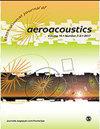Editorial for special issue on acoustic liners
IF 1.3
4区 工程技术
Q3 ACOUSTICS
引用次数: 0
Abstract
I am honored to present to the readers this special issue of the International Journal of Aeroacoustics on Acoustic Liners. Acoustic Liners have been studied since the introduction of turbojet engines and implemented shortly thereafter. Currently, almost all commercial turbofan engines nacelles have acoustic liners installed in somemanner. This Special Issue onAcoustic Liners provides 16 papers across a breadth of material – from analytical and numerical modelling to unique test rigs to evaluation of liner concepts. Contributors from academia, government agencies, and industry throughout the international community provide a range of insight. The focus is on the tried-and-true passive liner paradigmwhich continues to be the principal method of achieving noise reduction. The passive liner concept is straightforward – however, higher bypass ratios and shorter engine nacelles in advanced turbofans, as well as continuing demand for increased noise reduction while mitigating any performance impact, necessitates a continual improvement in liner acoustic performance and installation in novel locations. Therefore, continued study by the aeroacoustics community in this area is necessary to maintain our critical contribution to the improvement of the quality of life in communities near airports. I thank the authors for their contributions whose creativity and expertise are the basis of this issue. I sincerely appreciate the reviewers for their time spent in reviews and providing feedback which greatly improved the quality of the papers. I am grateful to the Editor-in-chief, Dr Ganesh Raman, and the International Journal of Aeroacoustics for providing an opportunity for publishing this special issue. In addition, my thanks are extended to Dr Ed Envia, Assistant Editor, who handled the papers for which I was an author.声学衬垫特刊社论
我很荣幸地向读者们介绍这期《国际声学声学杂志》的特刊。自涡轮喷气发动机问世以来,声学衬管就一直在研究,并在不久之后投入使用。目前,几乎所有商用涡扇发动机的短舱都以某种方式安装了声学衬垫。本期声学衬垫特刊提供了16篇论文,内容广泛,从分析和数值模拟到独特的测试平台,再到衬垫概念评估。来自学术界、政府机构和整个国际社会的工业界的贡献者提供了一系列的见解。重点是久经考验的真正的被动线性范例,它仍然是实现降噪的主要方法。被动尾管的概念很简单,但是,由于先进的涡扇发动机具有更高的涵道比和更短的发动机舱,以及在降低性能影响的同时不断提高降噪的需求,因此需要不断改进尾管的声学性能,并将其安装在新的位置。因此,空气声学学界在这一领域的持续研究是必要的,以保持我们对改善机场附近社区生活质量的重要贡献。我感谢作者的贡献,他们的创造力和专业知识是本期的基础。我真诚地感谢审稿人花时间审稿并提供反馈,极大地提高了论文的质量。我非常感谢主编Ganesh Raman博士和《国际空气声学杂志》为出版这一期特刊提供了机会。此外,我还要感谢助理编辑Ed Envia博士,他处理了我作为作者的论文。
本文章由计算机程序翻译,如有差异,请以英文原文为准。
求助全文
约1分钟内获得全文
求助全文
来源期刊

International Journal of Aeroacoustics
ACOUSTICS-ENGINEERING, AEROSPACE
CiteScore
2.10
自引率
10.00%
发文量
38
审稿时长
>12 weeks
期刊介绍:
International Journal of Aeroacoustics is a peer-reviewed journal publishing developments in all areas of fundamental and applied aeroacoustics. Fundamental topics include advances in understanding aeroacoustics phenomena; applied topics include all aspects of civil and military aircraft, automobile and high speed train aeroacoustics, and the impact of acoustics on structures. As well as original contributions, state of the art reviews and surveys will be published.
Subtopics include, among others, jet mixing noise; screech tones; broadband shock associated noise and methods for suppression; the near-ground acoustic environment of Short Take-Off and Vertical Landing (STOVL) aircraft; weapons bay aeroacoustics, cavity acoustics, closed-loop feedback control of aeroacoustic phenomena; computational aeroacoustics including high fidelity numerical simulations, and analytical acoustics.
 求助内容:
求助内容: 应助结果提醒方式:
应助结果提醒方式:


